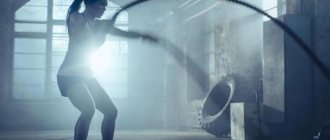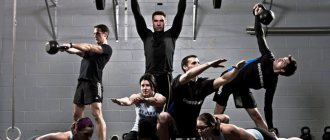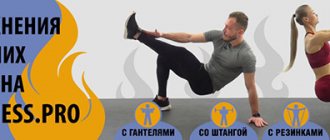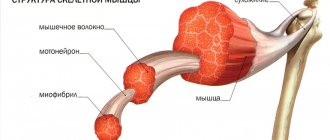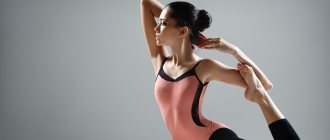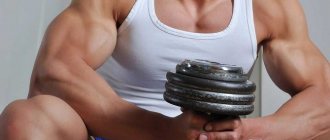Training program for hand development[edit | edit code]
- No special “specializations” are needed at this stage. You can also grow “linearly”, without cycling loads, while getting maximum benefits.
- The arm training program is designed for muscle development of the entire body, without isolating “manual” training on a separate day. It would be possible to make the program more radical in terms of training the arms, but for now it is more important to continue to progress in the basic movements to further progress in strength and mass throughout the body.
- It is very important to give your all in the “manual” exercises (the last 3 exercises on days 1 and 3), making small increases in weight each workout. The last approach is to failure, even if you get more repetitions than indicated. Psychological attitude: “let’s go fell a mammoth with our bare hands”! In these exercises, you can immediately begin to train hard, and in the rest, you can approach maximum weights only in the 4th week, reducing them at the beginning of the program. Be sure to make small weight increases (to the best of your ability) from workout to workout: 2kg, 1.5kg, 1kg or even 0.5kg (if we are talking about dumbbells). Constant increases of 2.5 kg will soon not allow you to perform the specified number of repetitions. There is no point in being “stuck” on one weight for a long time, up to 10 repetitions or more, and only then increasing the weight by 2.5 kg. Get small pancakes or make “additional weights” of the corresponding scales with a wire ring. Brutal efforts, coupled with precise technique (that’s the only way!) will do the trick.
- In the first 2 exercises of the 2nd day of the training program, it is necessary to monitor excellent technique, with pauses at the moment of peak muscle contraction. There is no need to force the weights.
Training program[edit | edit code]
Day 1
- Squats (full squat) - 2 warm-ups * 6 + 2 * 6 + 1 * 8-10 (with a weight reduction of 10-15 kg).
- Bench press - 2 warm-ups * 5 + 3 * 5 (with a step-by-step increase in weight by 2.5 kg between working approaches).
- French bench press - warm-up*8 + 2*8.
- Push-ups on uneven bars or from the floor (with a narrow position of the arms and turning the palms towards each other) - 2*max (leave only one approach by the 6th week, but plow until completely “stupid”).
- Standing barbell curls - 2 warm-ups*6 + 3*5-6 + 1*max (reduce weight by 5kg).
Day 2
- Rows on the upper block behind the head (wide grip; powerful contraction of the shoulder blades, maximum inclusion of the lats, not the arms) - 2 warm-ups + 3*6 or pull-ups behind the head (collect the sum 18 times in 3 approaches; if it’s easy, add a load).
- Bent-over row of a barbell to the waist (maximum exclusion of the pulling force of the arms from the movement - only with the back!) - 2 warm-ups * 6 + 2 * 6-8.
- Standing calves (any exercise) - 2 warm-ups + 3*6-8.
- Leg raises while hanging on the horizontal bar - 2*max (in the last approach - hang until your fingers unclench).
- Lying body raises with a load behind the head - 2*12-15.
Day 3
- Seated dumbbell press - 2 warm-ups * 6 + 2 * 6-8.
- Deadlift - 3 warm-ups * 5 + 3 * 5.
- Bench press with a narrow grip (40 cm between the palms) - 2 warm-ups * 6 + 2 * 6-8 + 1 * max (reduce weight by 7.5 kg).
- Alternating standing arm curls with dumbbells - 2 warm-ups * 6 + 2 * 5-6.
- Alternating “hammer” curls while standing with dumbbells 2*6-8 (leave only one set for the 6th week, but work until you are completely “stupid”).
Notes[edit | edit code]
Warm-ups in % of working weights (calculated at the beginning of the program and remain unchanged until the end):
- 3 warm-ups - 40%, 55-60%, 75% (deadlift);
- 2 warm-ups - 50%, 75%;
- 1 warm-up – 60-65%.
Arm training takes place three times a week; only 8 weeks. If it is possible to further increase the working weights without disturbing the technique, continue for another 2 weeks. If insufficient recovery affects progress in working weights in basic exercises, add a rest day between workouts.
Matt Kroshaleski
Swing according to the “pyramid” scheme with a permanent resident of the “Muscles and Fitness” resource, crazy about games with iron.
MuscleTech-sponsored athlete Matt Kroshaleski, one of the strongest powerlifters in history, decided to try his talents in the field of bodybuilding. And if we consider his new figure as an indicator, then the training methods he uses are what we need!
Kroc, known for his now unpopular high-intensity garage workouts, uses longer workouts than most to force his muscles to grow.
His program is based on several basic exercises, the number of repetitions of which is performed in a pyramid-like pattern. A unique element is added at the end: a triple drop set, performed as the final set of each exercise.
To do this, reduce the weight by 20-25% in each subsequent set, performed without rest. Then push yourself through three quick sets without rest until you are completely exhausted. “This will cause a ton of blood to rush into your arms,” says Kroszaleski, “stretching the fascia and making room for new muscle cells to grow.”
As you complete the first three sets, increase the weight on each exercise. Start with a weight that you can perform a high number of reps with, then add enough weight so that each set is challenging enough, but not so difficult that you become exhausted before you finish the target number of reps.
Program in the hands of Matt Kroshaleski
Close grip bench press triple drop set in the last set
4
sets of
10, 8, 6, max.
repetitions
Triceps extension on the upper block triple drop set in the last set
4
sets of
15, 12, 8, max.
repetitions
French bench press triple drop set in the last set
4
sets of
15, 12, 8, max.
repetitions
Bench push-ups from behind the back 1
set of
100
repetitions
Barbell curls for biceps triple drop set in the last approach
4
sets of
20, 15, 10, max.
repetitions
EZ-barbell biceps curl on a Scott bench, triple drop set in the last set,
4
sets of
20, 15, 10, max.
repetitions
Biceps curl with forward bend triple drop set in the last set
4
sets of
20, 15, 10, max.
repetitions
Biceps curl on a block in a lying position triple drop set in the last set
4
sets of
20, 15, 10, max.
repetitions
Part 1
| Part 2 | Part 3
Are isolation exercises necessary for biceps and triceps[edit | edit code]
Translation from English and adaptation of the text: Andris Broks
During the experiment, scientists from the University of Brasilia found that for the development of biceps and triceps, multi-joint exercises, such as bench press and lat pulldown, are sufficient, while isolation exercises are not necessary.
Research results
Scientists divided 29 male students into two groups, which trained their upper body twice a week in the gym. One group performed bench presses, lat pulldowns, incline dumbbell flyes, and bent over rows (MJ). The other group performed the same exercises for the same number of sets, but added two single-joint exercises to the program: biceps curls and triceps extensions (MJ+SJ).
The researchers measured muscle size and strength in the subjects' upper arms before the experiment and after completing a 10-week strength training program.
results
The group that added biceps curls and triceps extensions to their workouts gained almost the same amount of muscle mass in their upper arms as the group that did only the core upper-body training program. The difference between both groups was not statistically significant. Thus, both groups gained the same amount of muscle mass.
The situation is the same with the increase in strength indicators in biceps curls. The increase in strength indicators in the subjects who added biceps curls to the main training was slightly greater than in the control group, but the difference was not statistically significant. Thus, both groups increased their strength indicators approximately equally.
Overall, this study showed that the loads generated by multi-joint exercises were sufficient to stimulate gains in muscle size and strength in untrained individuals. There was no evidence of additional benefit from additional single-joint exercises over a 10-week period.
Recommendations for training
Due to the small size of muscles and the possibility of cheating in exercises, there are the following training recommendations:
- Work one arm muscle group per workout. For example, back + biceps or chest + triceps (the principle of training synergistic muscles). This optimizes the workflow and allows you to combine heavy basic movements with special ones. Experienced athletes can specialize in arms, training them completely in one day. This approach is not recommended for beginners.
- If you do biceps after back or triceps after chest, a couple of exercises will be enough for them. If you do 4-5, this will lead to overtraining and your arms will not grow. The same thing can happen if your split is built like this: back + triceps, chest + biceps. In this case, the biceps will work 2 times a week, and the triceps will work 3 times a week (another time on shoulder day during presses). It's too much.
- Work in a multi-rep style - 10-15 repetitions. This reduces the risk of injury and increases blood flow into the muscles. Small muscles respond better to such a load, since they were not originally designed to lift large weights.
- Perform exercises with strict technique. Leave cheating to professional athletes. It will be much more effective to lift a 25 kg barbell absolutely cleanly on your biceps than to throw 35 kg with your body and shoulders.
- Don’t get carried away with pumping, supersets and drop sets. Using the example above, again, it will be more effective to lift a 25 kg barbell for biceps for 12 reps than to do 15 kg for 20 reps or 15-10-5 kg for 10 reps (drop set). These techniques are best used when you reach a certain plateau in weight gain, already having experience in strength training and decent working weights.
Is it possible to get a beautiful buttock shape through training?
Yes, but only to a certain extent. “The shape of the buttocks is given to us by nature and, of course, arguing with genetics is in some sense useless,” comments Elena Chindyaeva, expert trainer at the World Gym club, author of slimming marathons, and nutrition consultant .
- Therefore, we cannot radically change the shape of the buttocks. However, all this does not negate the need to train this area: with the help of exercises we can adjust the size, “raise” the buttocks, strengthen and tone them, as well as get rid of looseness and cellulite.” “We can only partially influence the shape of the buttocks: the percentage of subcutaneous fat can be adjusted with nutrition, and the condition of the muscles can be improved with exercise,” says Elena Kirsanova, trainer at the Milon . “The main thing to remember is that for the desired shape of the buttocks, both conditions must be met, otherwise the desired result will not be achieved.”
That is, once again: you shouldn’t expect any special miracles from training, but you don’t need to give them up either - toned buttocks and thighs (after all, these zones cannot be worked out separately) have a positive effect on the health of the back and knees, and also help burn more calories in state of rest. “When the buttocks do not work properly, the entire musculoskeletal system suffers, and as a result, curvature of the spine occurs,” adds Elena Chindyaeva. — The load is distributed incorrectly, and the lumbar region suffers first and the back is overloaded. As a rule, the abdominal and pelvic floor muscles also do not work or are weakened. The quadriceps also compensate for non-working buttocks; a large load falls on the knee joints.” And, of course, firm buttocks are simply beautiful.


